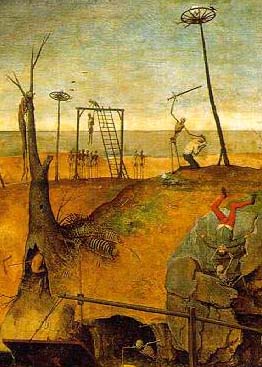Many of Pieter Bruegel's paintings can be viewed on the web, along with biographical information and art criticism. Seen above, as well as in Monty Python's Flying Circus' famous "Spanish Inquisition sketch", is a portion of "The Triumph of Death" (1562), currently displayed in the Prado in Madrid. Note also "Dulle Griet" ("Mad Meg"), another favorite of THIS web site. The South Hill Brass invites you to form your OWN opinions about Pieter Bruegel the Elder. |
The South Hill Brass Presents Pieter Bruegel the Elder |
NOBODY expects the South Hill Brass to have a "Pieter Bruegel" page ... |
To date, the Un-Authorized Official South Hill Brass Home Page has featured more works by Pieter Bruegel than by any other sixteenth-century Flemish painter. While his works survive, and can be admired by all, the "experts" seem to agree only on the fact that Pieter Bruegel, known as "the Elder", remains enigmatic. |
Some dismiss Bruegel's work as mostly scenes from ordinary peasant life ("genre" pictures), but even these have a deeper moral and humanistic significance. He also painted religious subjects, and fantastic scenes on literary bases, using proverbs as a starting point. |
H. W. Janson, in his History of Art, ponders, "What were his religious convictions, his political sympathies? We know little about him, but his preoccupation with folk customs and the daily life of humble people seems to have sprung from a complex philosophical attitude. Bruegel was highly educated, the friend of humanists, and patronized by the Hapsburg court. Yet he apparently never worked for the Church, and when he dealt with religious subjects he did so in an oddly ambiguoius way." |
Pieter Bruegel (he MAY have originally spelled his name "Brueghel", before dropping the "h" -- his descendants again adopted the "Brueghel" spelling) was born in either the Flemish town of Brueghel or Breda, and the disputed year of his birth is often written as 1525/30. He studied painting in the city of Antwerp, first with Pieter Coecke van Aelst and later with Hieronymous Cock. He traveled in Italy from perhaps 1551 to 1555 before returning to Antwerp. Around 1563, he settled in Brussels and married Pieter Coecke's daughter (named "Maria" or maybe "Mayken"). Most of his paintings date from 1556 to 1569. |
This was a time of Spanish occupation and war in the region. In Masters of Painting, Bernardine Kielty writes, "It was a dangerous time to portray cruelty and injustice, but that is exactly what the intrepid Bruegel did. In "The Carrying of the Cross" he pictured the Spanish atrocities by means of a Bible story. Gallows are scattered over the landscape, the soldiers moving toward the Cross are in the uniform of the Spanish infantry, the people are clearly in agony." |
Pieter Bruegel the Elder died in 1569 (sometime between September 5th and 9th), at no more than 44 years of age. He left behind his wife, and two sons who also became painters, Pieter (known as "Hell" for his bizarre taste in subject matter), and Jan (who preferred painting things like flowers, and was known as "Velvet"). They and their descendants continued a family dynasty of painters that would last for over one hundred years. |
Many of Pieter Bruegel's paintings can be viewed on the web, along with biographical information and art criticism. Seen above, as well as in Monty Python's Flying Circus' famous "Spanish Inquisition sketch", is a portion of "The Triumph of Death" (1562), currently displayed in the Prado in Madrid. Note also "Dulle Griet" ("Mad Meg"), another favorite of THIS web site. The South Hill Brass invites you to form your OWN opinions about Pieter Bruegel the Elder. |
visitors since 16 June 1999 |


